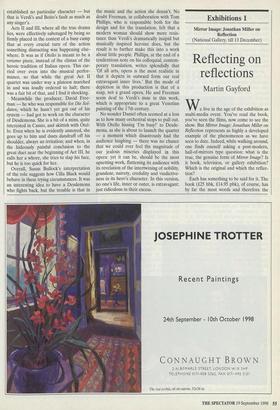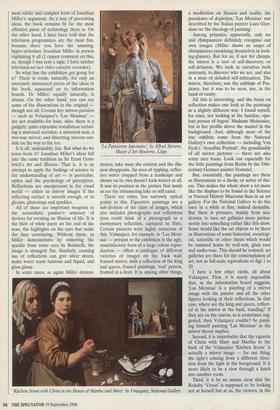Exhibitions 1
Mirror Image: Jonathan Miller on Reflection (National Gallery, till 13 December)
Reflecting on reflections
Martin Gayford
We live in the age of the exhibition as multi-media event. You've read the book, you've seen the films, now come to see the show. But Mirror Image: Jonathan Miller on Reflection represents as highly a developed example of the phenomenon as we have seen to date. Indeed, while walking around, one finds oneself asking a post-modern, hall-of-mirrors type question: what is the true, the genuine form of Mirror Image? Is it book, television, or gallery exhibition? Which is the original and which the reflec- tion?
Each has something to be said for it. The book (£25 hbk, £14.95 pbk), of course, has by far the most words and therefore the most subtle and complex form of Jonathan Miller's argument. As a way of presenting ideas, the book remains by far the most effective piece of technology there is. On the other hand, I have been told that the television programmes are the most fun, because there you have the amusing, hyper-articulate Jonathan Miller in person explaining it all (I cannot comment on this, as, though I was sent a tape, I have neither television set nor video cassette recorder).
So what has the exhibition got going for it? There is room, naturally, for only an extremely attenuated précis of the ideas in the book, squeezed on to information boards. Dr Miller, equally naturally, is absent. On the other hand, you can see some of the illustrations in the original though not all. Certain key mirror-pictures — such as Velazquez's 'Las Meninas' are not available for loan. Also, there is a gadgety, quite enjoyable installation includ- ing a mirrored corridor, a mirrored seat, a two-way mirror, and distorting mirrors out- side on the way to the loo.
It is all, undeniably, fun. But what do we learn from it? Jonathan Miller's ideas fall into the same tradition as Sir Ernst Gom- brich's Art and Illusion. That is, it is an attempt to apply the findings of science to the understanding of art — in particular, optics and the psychology of perception. Reflections are omnipresent in the visual world — either as mirror images if the reflecting surface is smooth enough, or as gleams, glistenings and sparkles.
All of these are important weapons in the naturalistic painter's armoury of devices for creating an illusion of life. It is the blob of white paint on the end of the nose, the highlights on the eyes that make the face convincing. Without them, as Miller demonstrates by removing the sparkle from some eyes by Botticelli, the image is strangely flat. Similarly, cunning use of reflections can give silver sheen, make water seem lustrous and liquid, and glass glassy.
In some cases, as again Miller demon- `La Parisienne Japonaise; by Alfred Stevens, Musee d'Art Modeme, Liege strates, take away the context and the illu- sion disappears. An area of rippling, reflec- tive water cropped from a landscape and shown on its own doesn't look watery at all. It was its position in the picture that made us see the shimmering lake or still canal.
There are other, less narrowly optical points to this. Figurative paintings are a sub-division of the class of images, which also includes photographs and reflections (you could think of a photograph as a momentary reflection, captured on film). Certain painters were highly conscious of this. Velazquez, for example in 'Las Meni- nas' — present in the exhibition in the ugly, unsatisfactory form of a large colour repro- duction — offers a catalogue of different varieties of images on the back wall: framed mirror, with a reflection of the king and queen, framed paintings, 'real' person, framed in a door. It is, among other things, 'Kitchen Scene with Christ in the House of Martha and Mary; by Velazquez, National Gallery a meditation on illusion and reality, the paradoxes of depiction. 'Las Meninas' was described by the Italian painter Luca Gior- dano as 'the theology of painting'.
Among primates, apparently, only we and chimpanzees definitely recognise our own images (Miller shows us snaps of chimpanzees examining themselves in look- ing-glasses). But for us, if not for chimps, the mirror is a tool of self-discovery, or self-delusion. We look at ourselves both anxiously, to discover who we are, and also in a state of deluded self-infatuation. The mirror, therefore, was the emblem of Pru- dence, but it was to be seen, too, in the hand of vanity.
All this is interesting, and the focus on reflection makes one look at the paintings in a slightly different way. I found myself, for once, not looking at the familiar, opu- lent person of Ingres' Madame Moitessier, but at her profile above the mantel in the background. And, although most of the star exhibits come from the National Gallery's own collection — including Van Eyck's Arnolfini Portrait', the granddaddy of all mirror pictures — there are also some nice loans. Look out especially for the little paintings from Berlin by the 19th- century German painter Hummel.
But, essentially, the paintings are there as illustrations to a thesis, or series of the- ses. This makes the whole show a lot more like the displays to be found in the Science or Natural History Museums than in an art gallery. For the National Gallery to do this once in a while is fine, indeed desirable. But there is pressure, mainly from aca- demics, to turn art galleries more perma- nently into something rather like this show. Some would like the art objects to be there as illustrations of some historical, sociologi- cal, scientific or other thesis which would be rammed home by wall-text, glass case and audio-tour. This should be resisted; art galleries are there for the contemplation of art, not as full-scale equivalents to figs 1 to 20.
I have a few other cavils, all about Velazquez. First, it is surely impossible that, as the information board suggests, `Las Meninas' is a painting of a mirror image with the painter and all the other figures looking at their reflections. In that case, where are the king and queen, reflect- ed in the mirror at the back, standing? If they are on the canvas, as is sometimes sug- gested, then Velazquez couldn't be paint- ing himself painting 'Las Meninas' as the mirror theory implies.
Second, it is improbable that the vignette of Christ with Mary and Martha to the back of the Velazquez 'Kitchen Scene' is actually a mirror image — for one thing, the light's coming from a different direc- tion from the light in the foreground. It is more likely to be a view through a hatch into another room.
Third, it is by no means clear that the Rokeby 'Venus' is supposed to be looking not at herself but at us, the viewers, in the mirror (a point beloved of smart-Alecky people). True, as the exhibition text points out, if we can see her, she can see us. But, as a slightly salacious art-historical photo- graphic reconstruction showed, a mirror held at an angle in that position would reflect Venus's midriff. Velazquez doubt- less painted her face there because, for var- ious reasons, moral and aesthetic, it made a better painting that way. He was entirely willing, as analysis of 'Las Meninas' shows, to override the objective facts of optics and perspective if it suited him to do so. In the end, art is not science. But go to see this enjoyable exhibition anyway, and prefer- ably read the book first.












































































 Previous page
Previous page